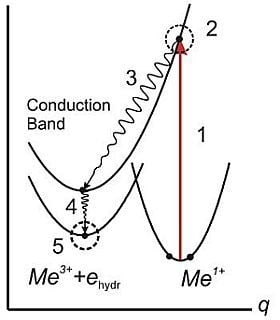Semiconductor CdF2:Ga and CdF2:In Crystals as Media for Real-Time Holography
Abstract
:1. Introduction
2. Bistable Centers in CdF2 Crystals and Their Transformations
2.1. The Nature of Bistable Centers in CdF2 Crystals
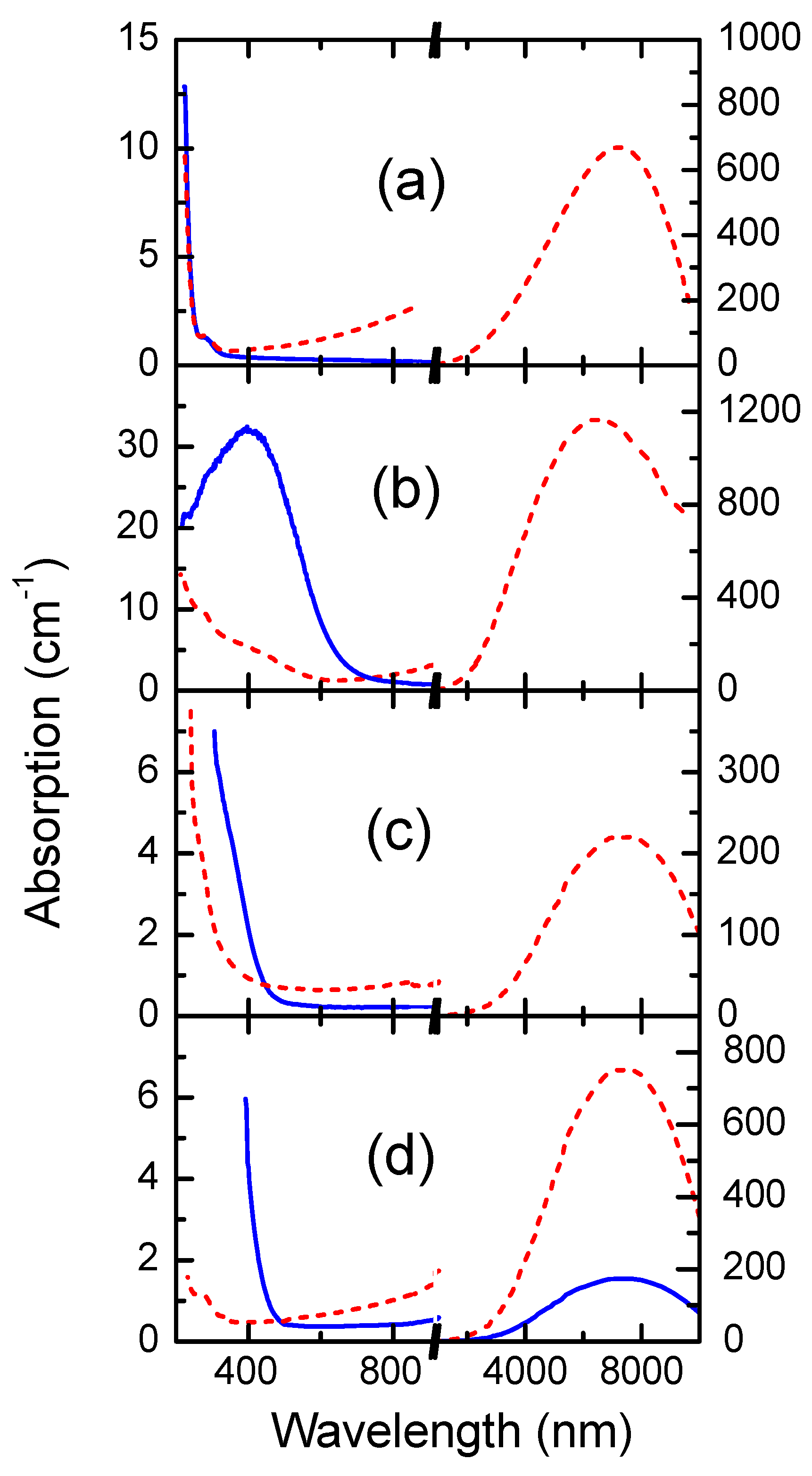
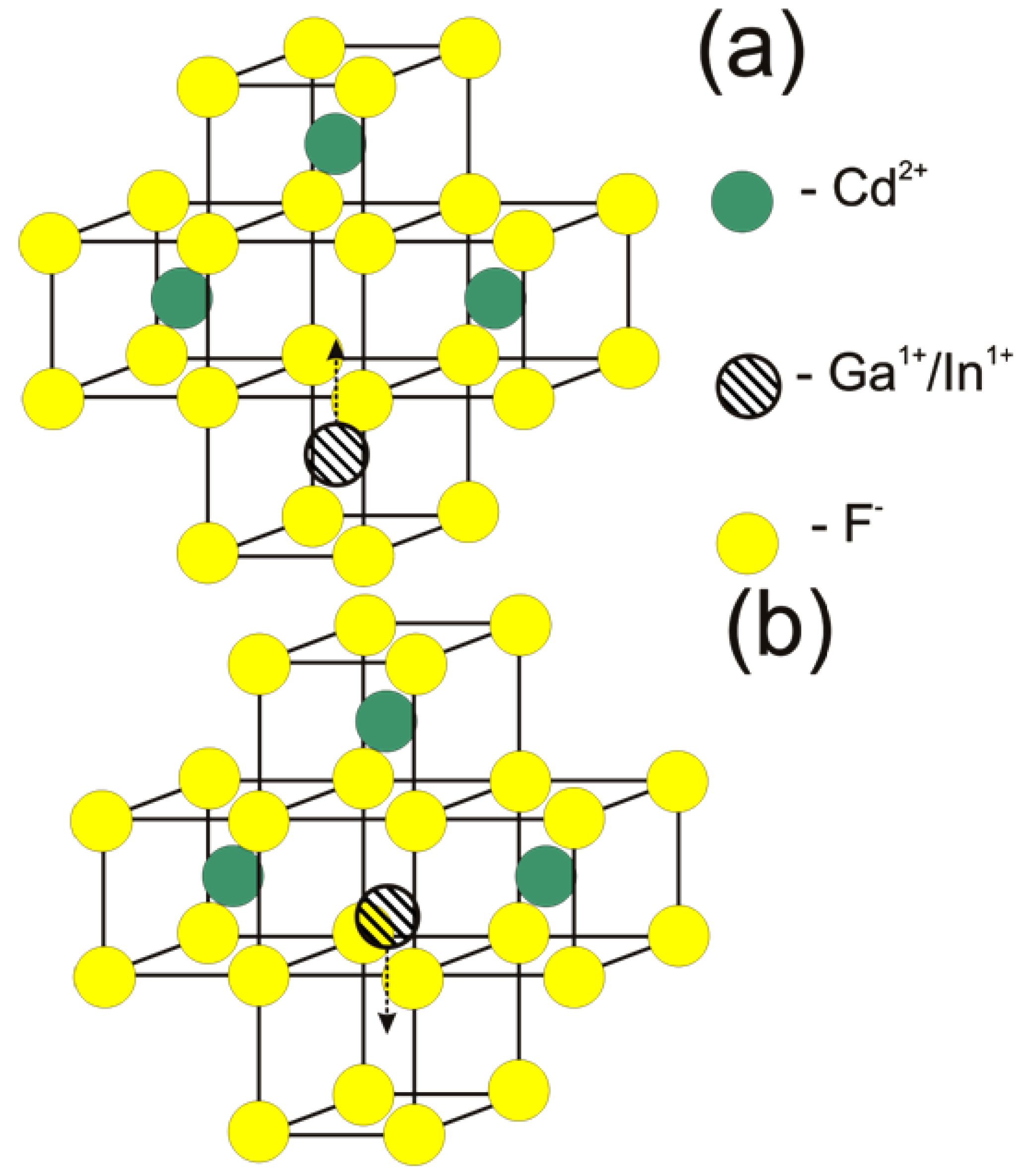
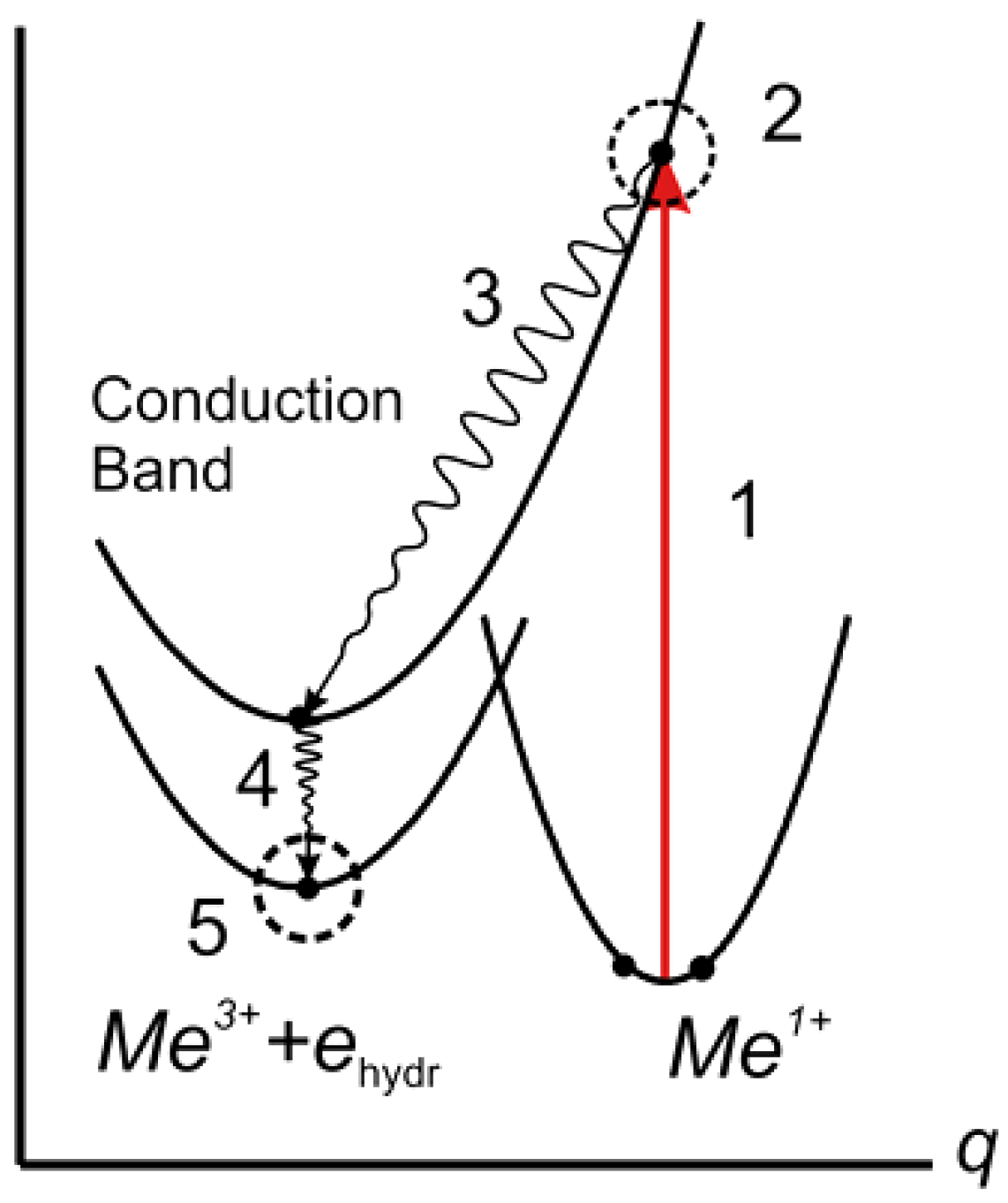
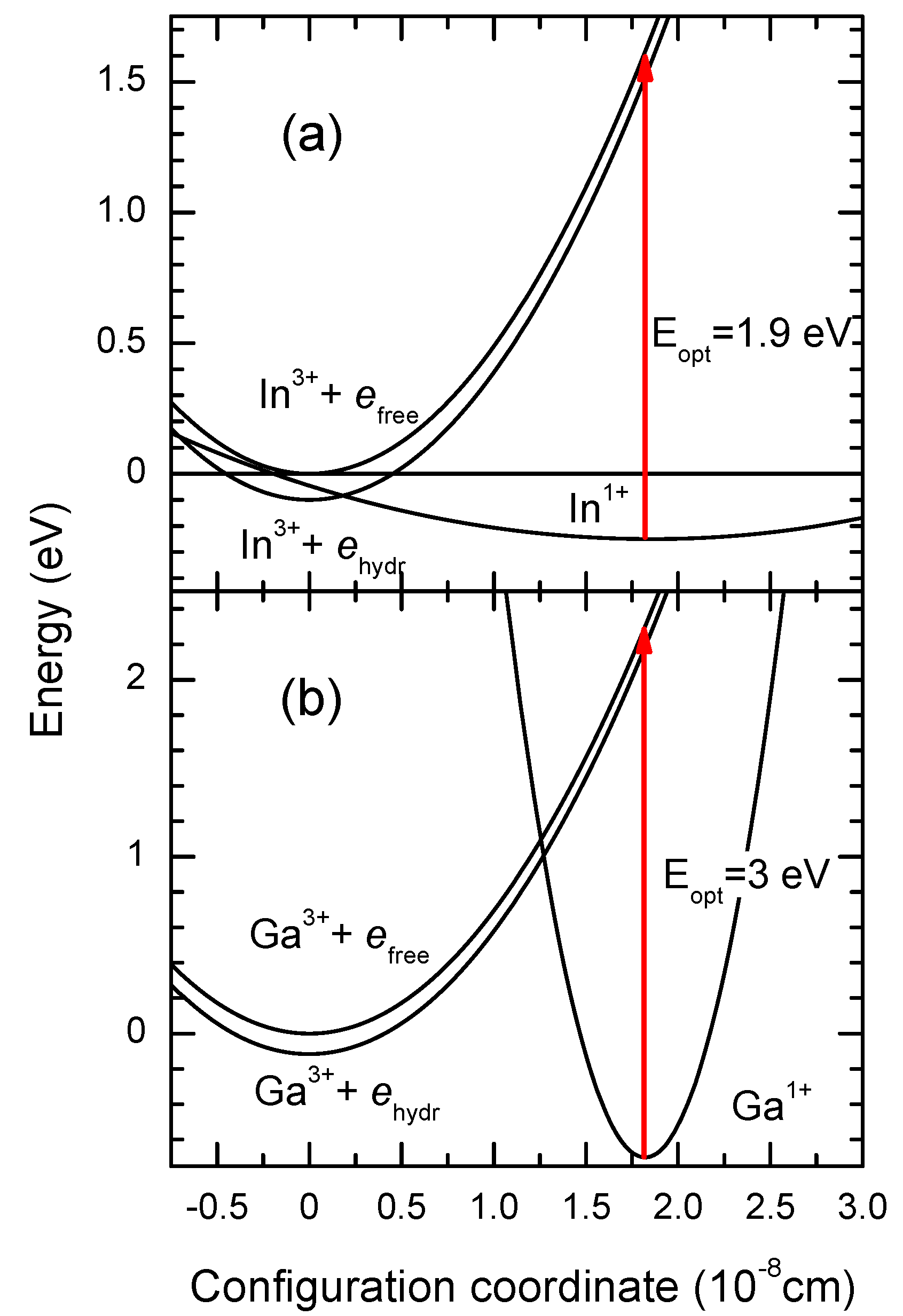
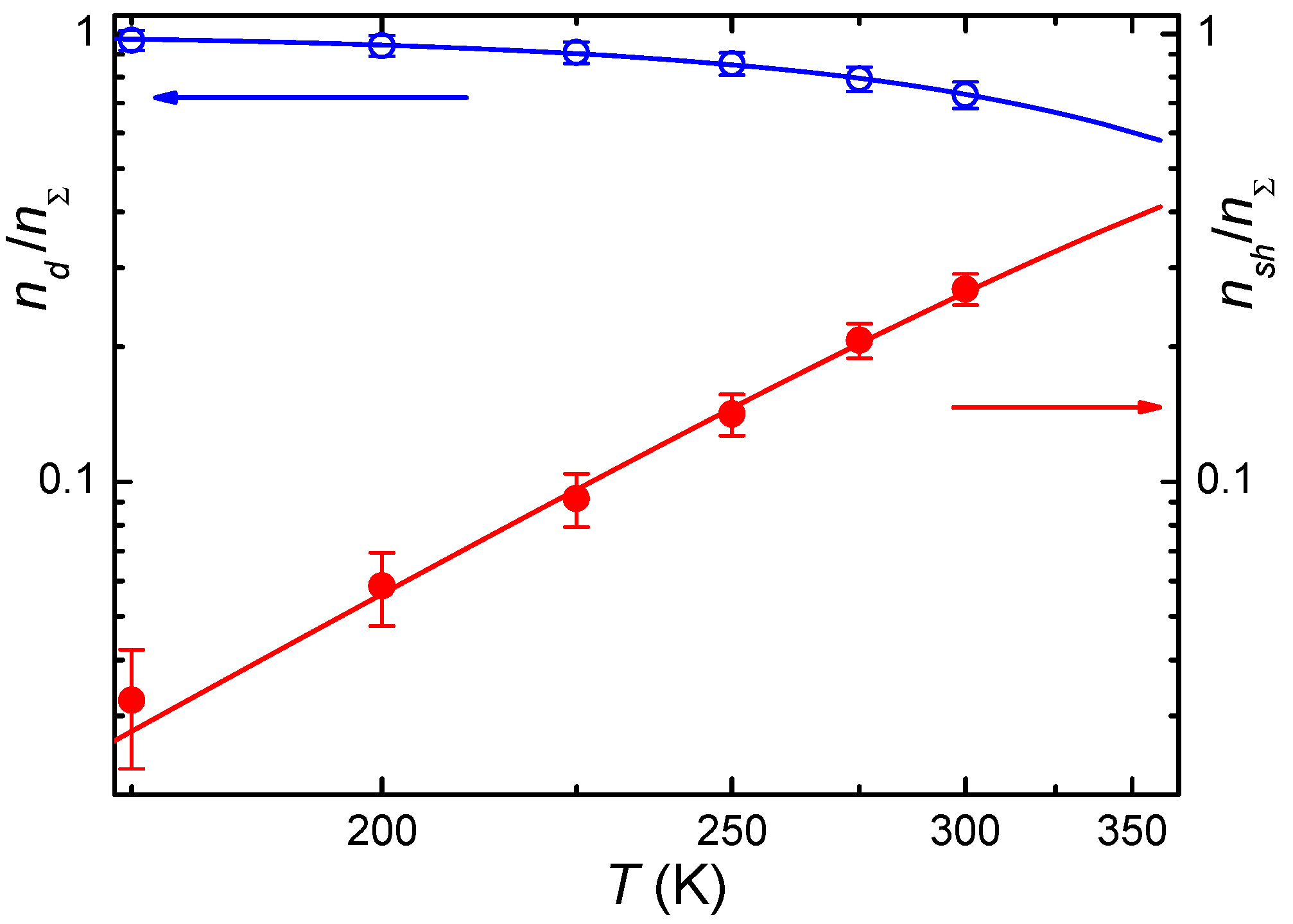
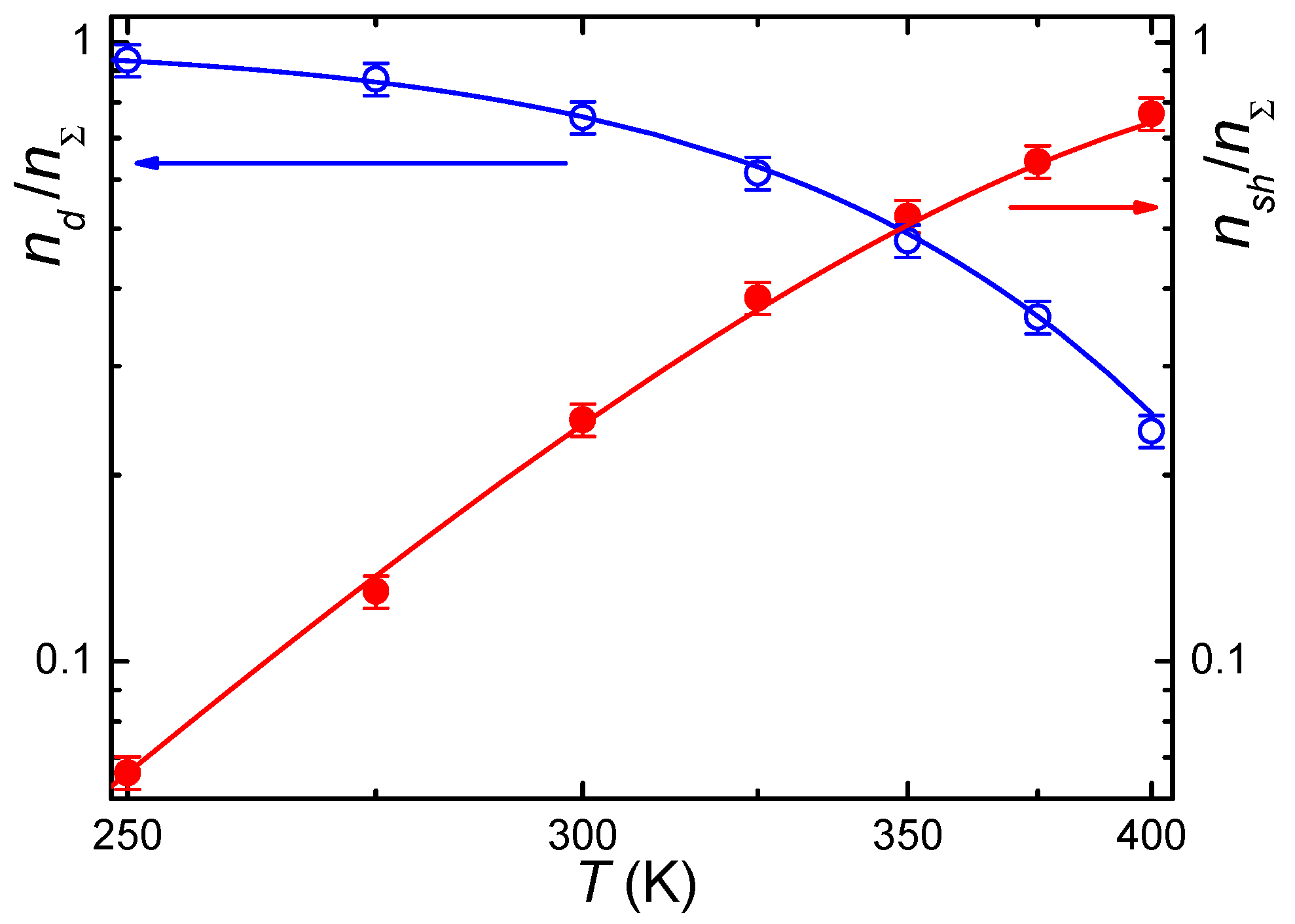
2.2. Kinetics of Photo- and Thermal-Transformations of Bistable Centers
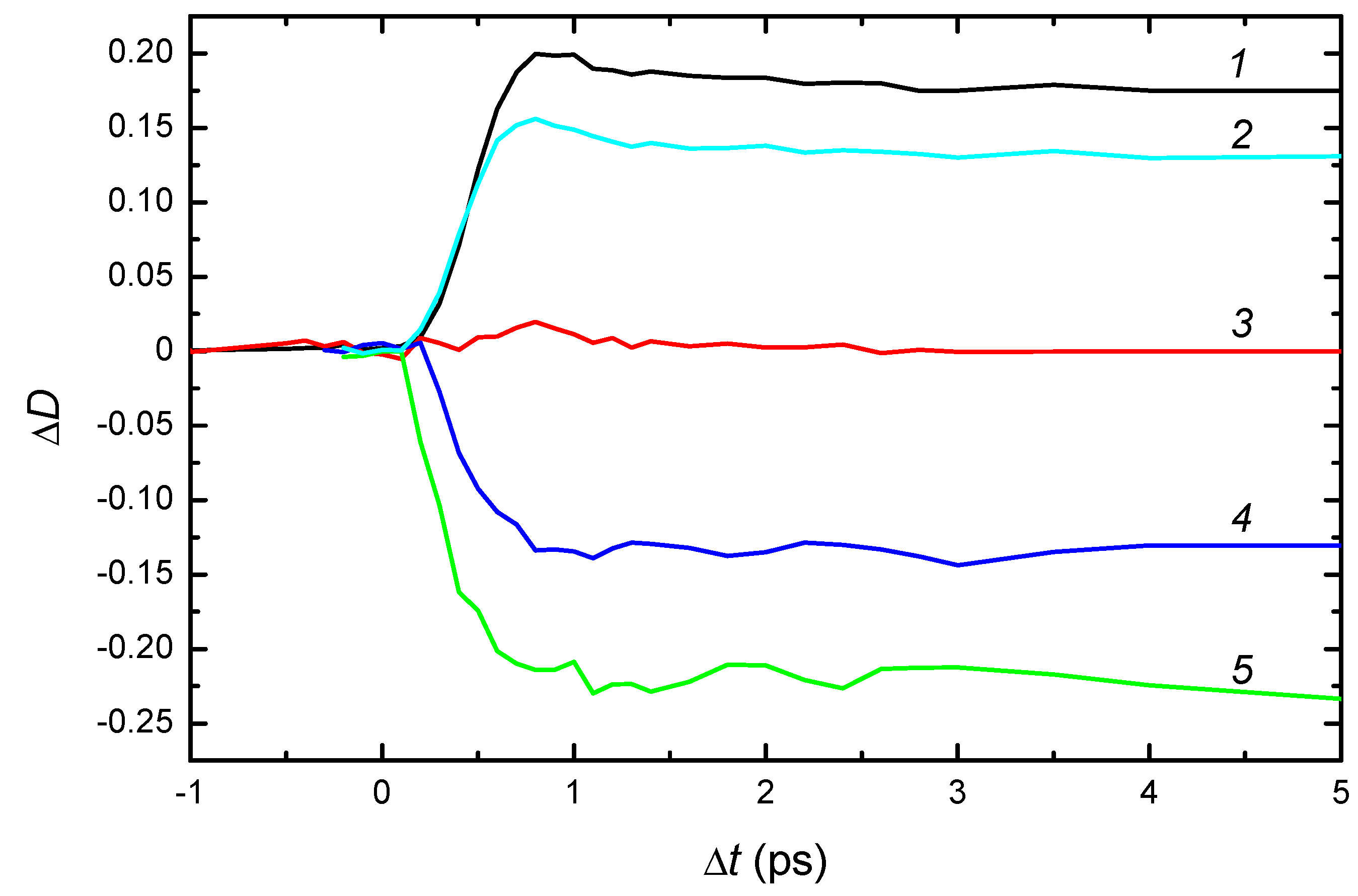
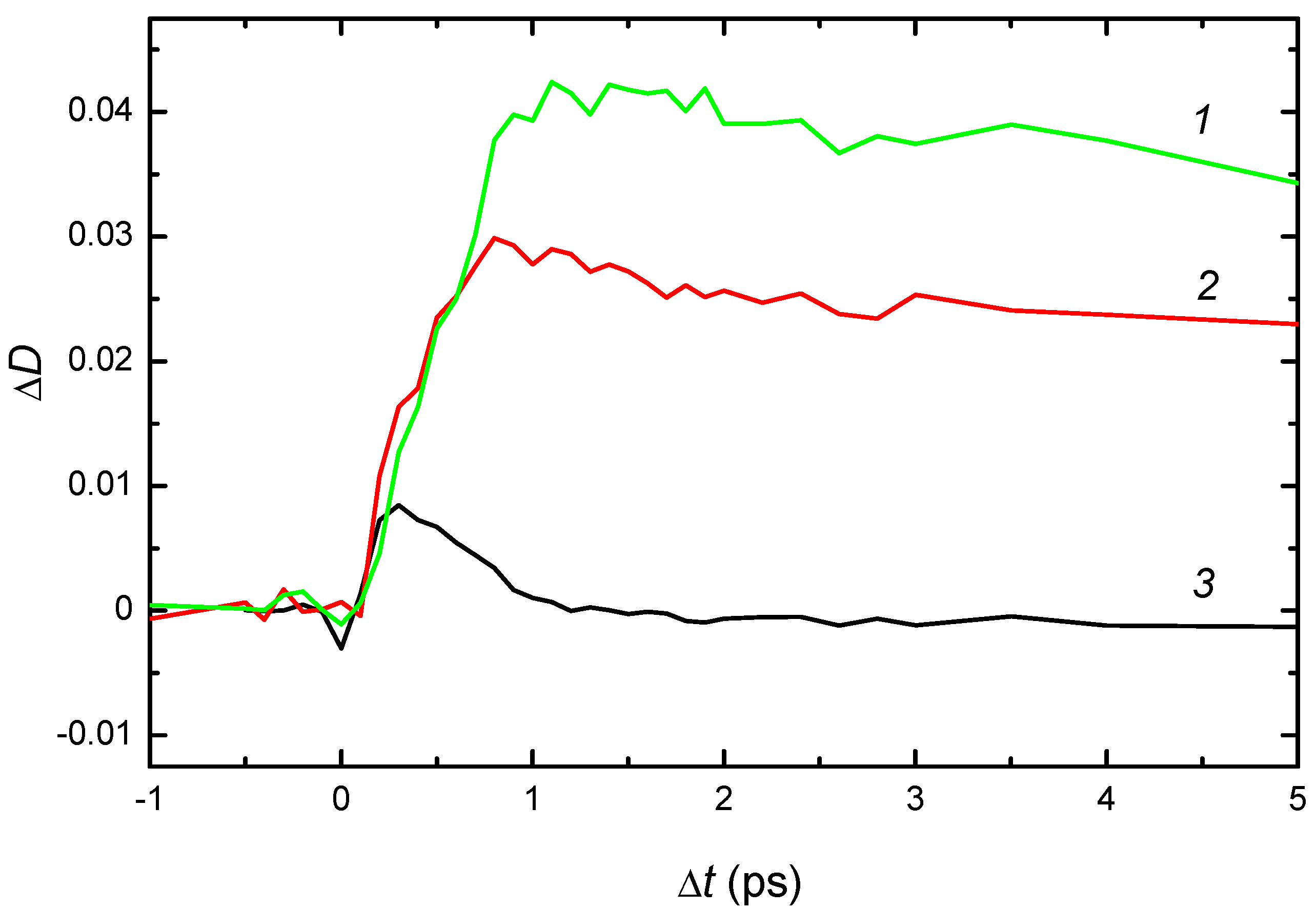

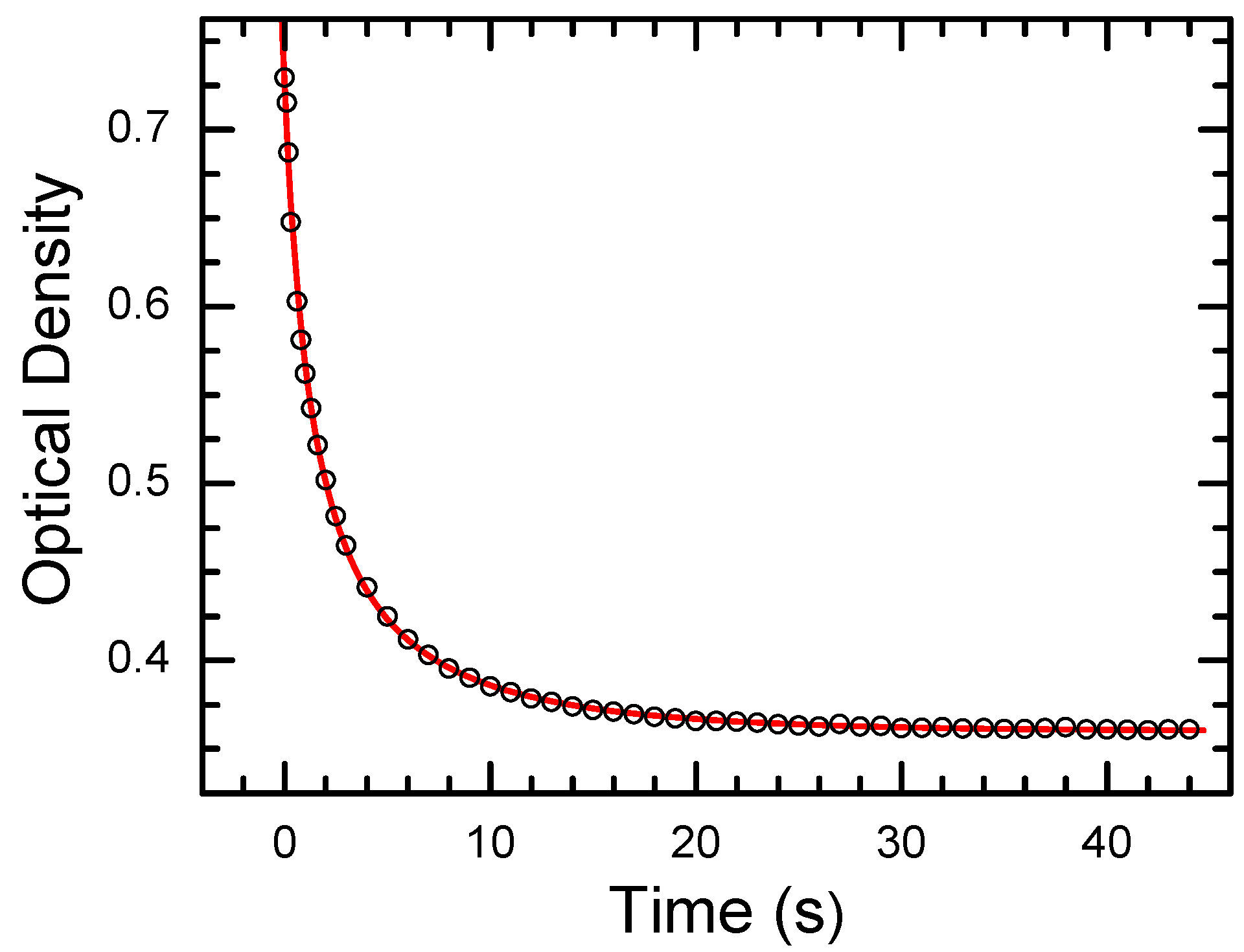
3. CdF2 Crystals with Bistable Impurity Centers as a Holographic Media
3.1. Diffraction Efficiency and Hologram Decay
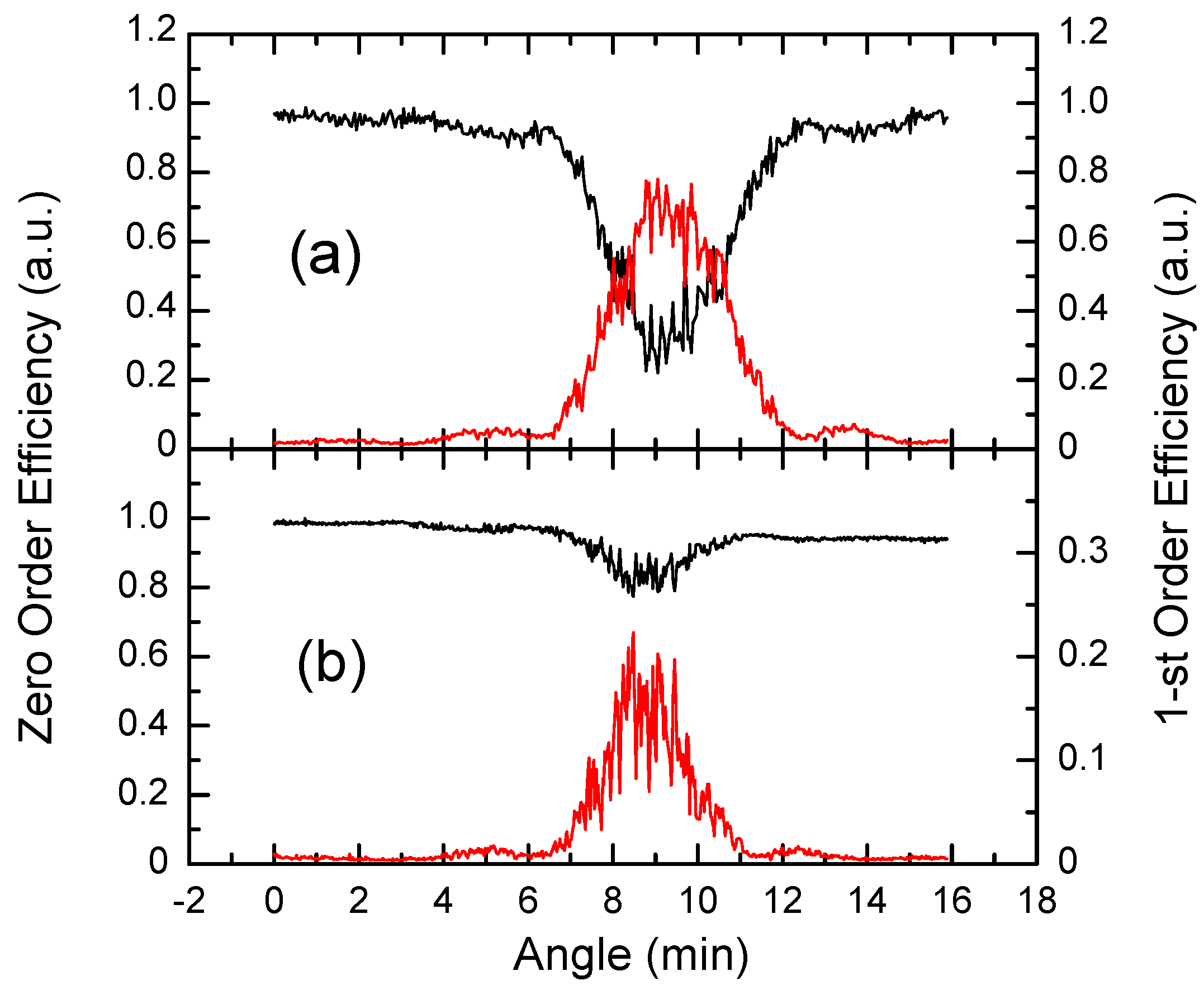
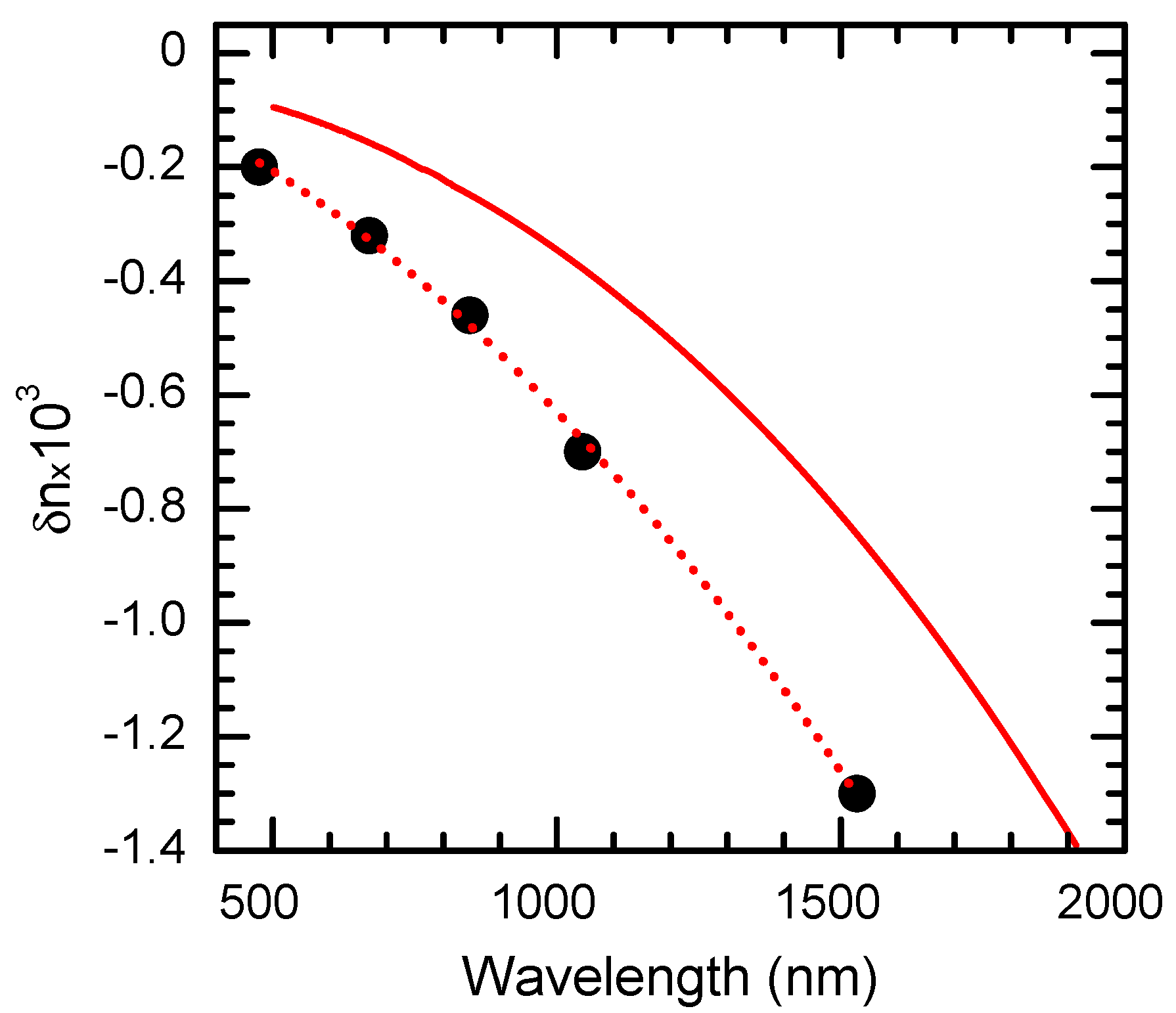
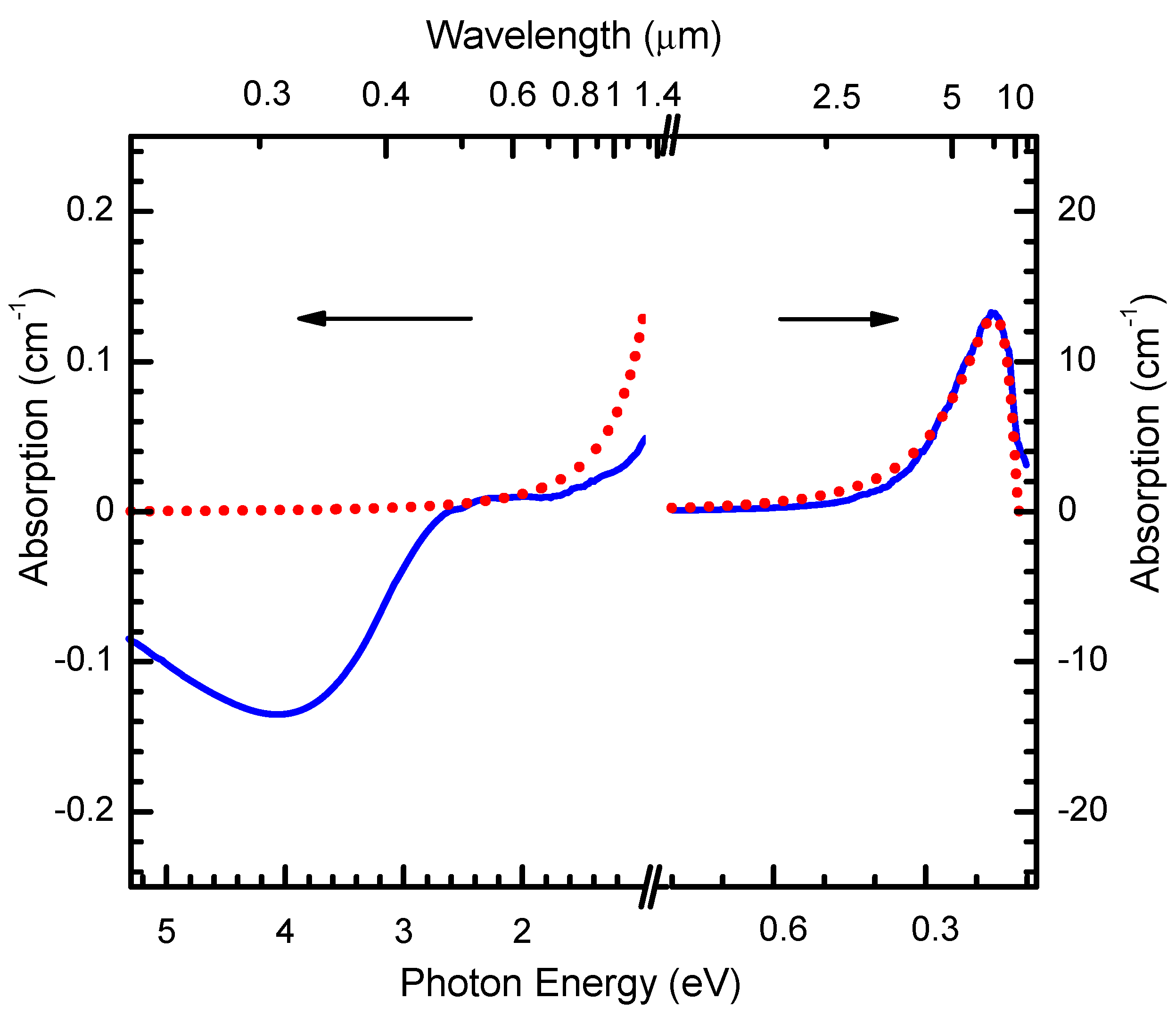

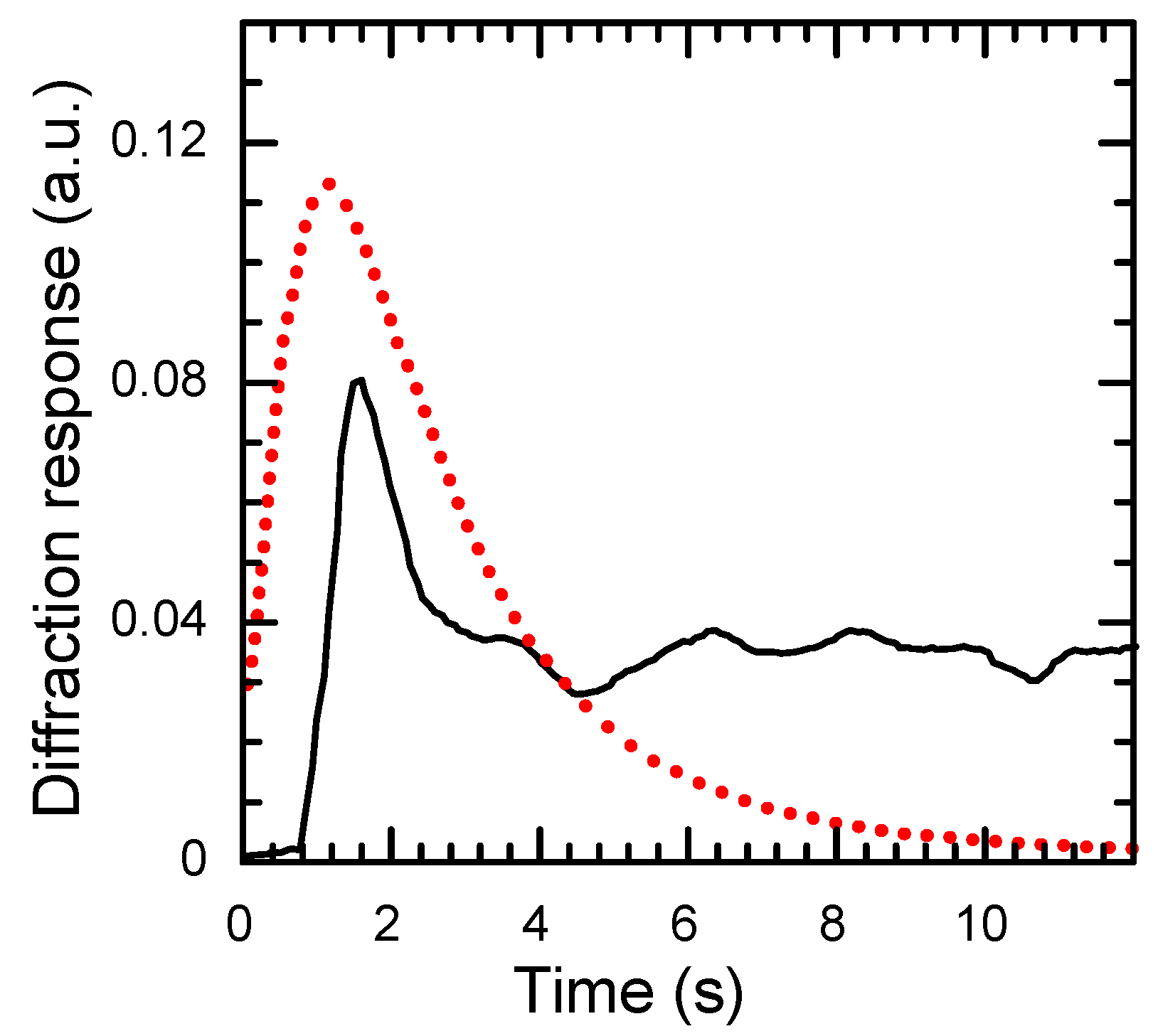

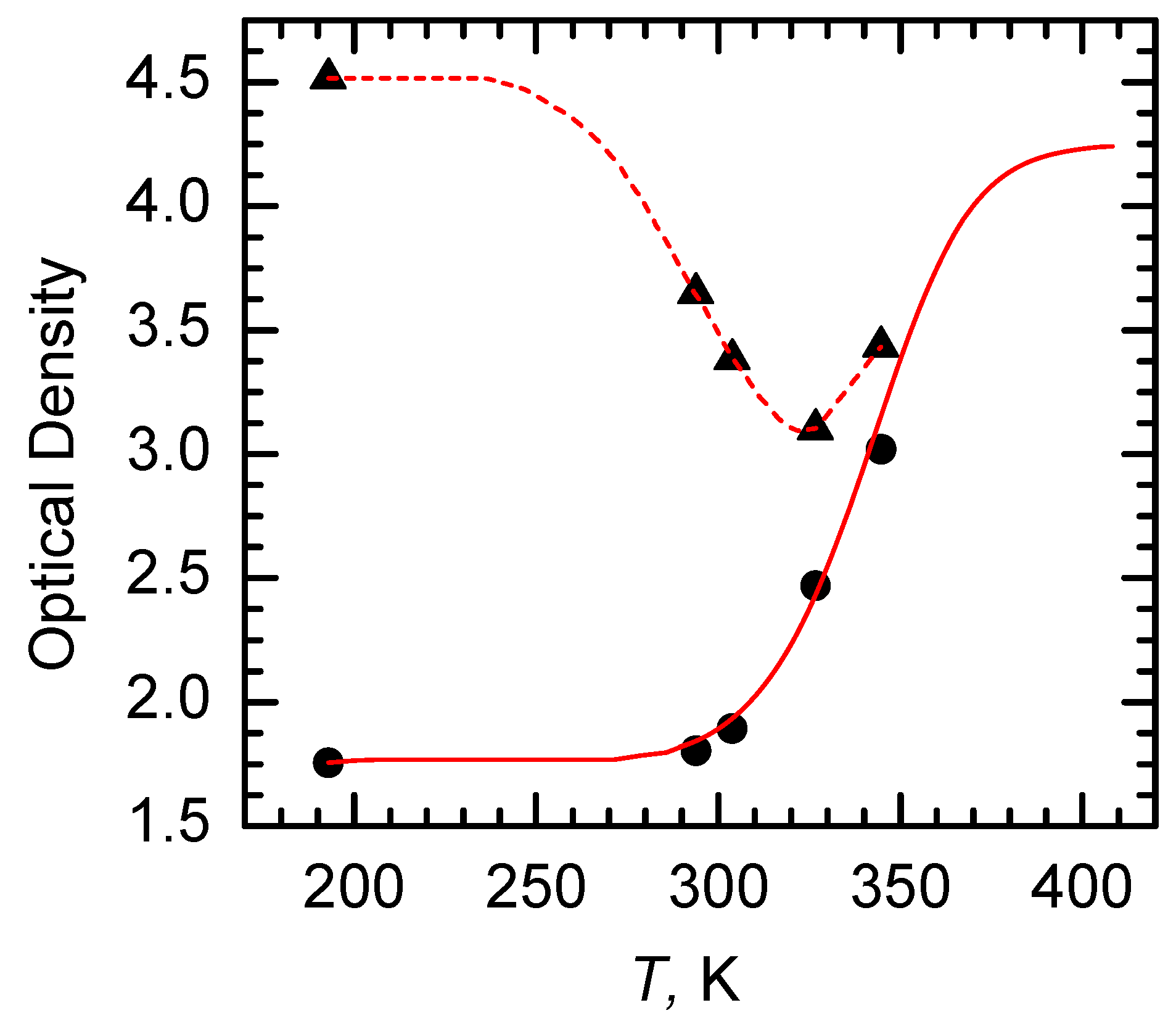

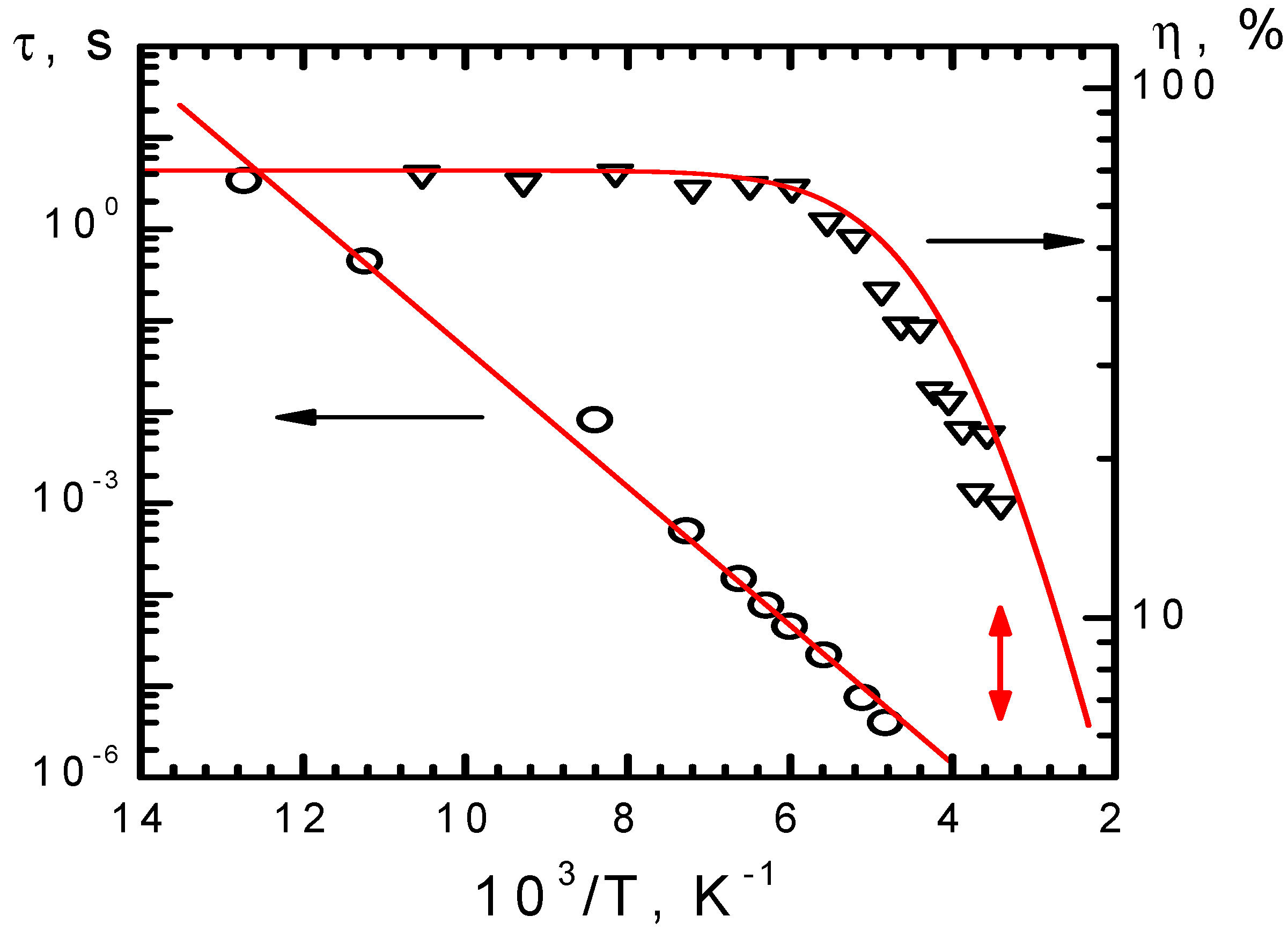
3.2. Holographic Media Resolution, Sensitivity and Operation Mode
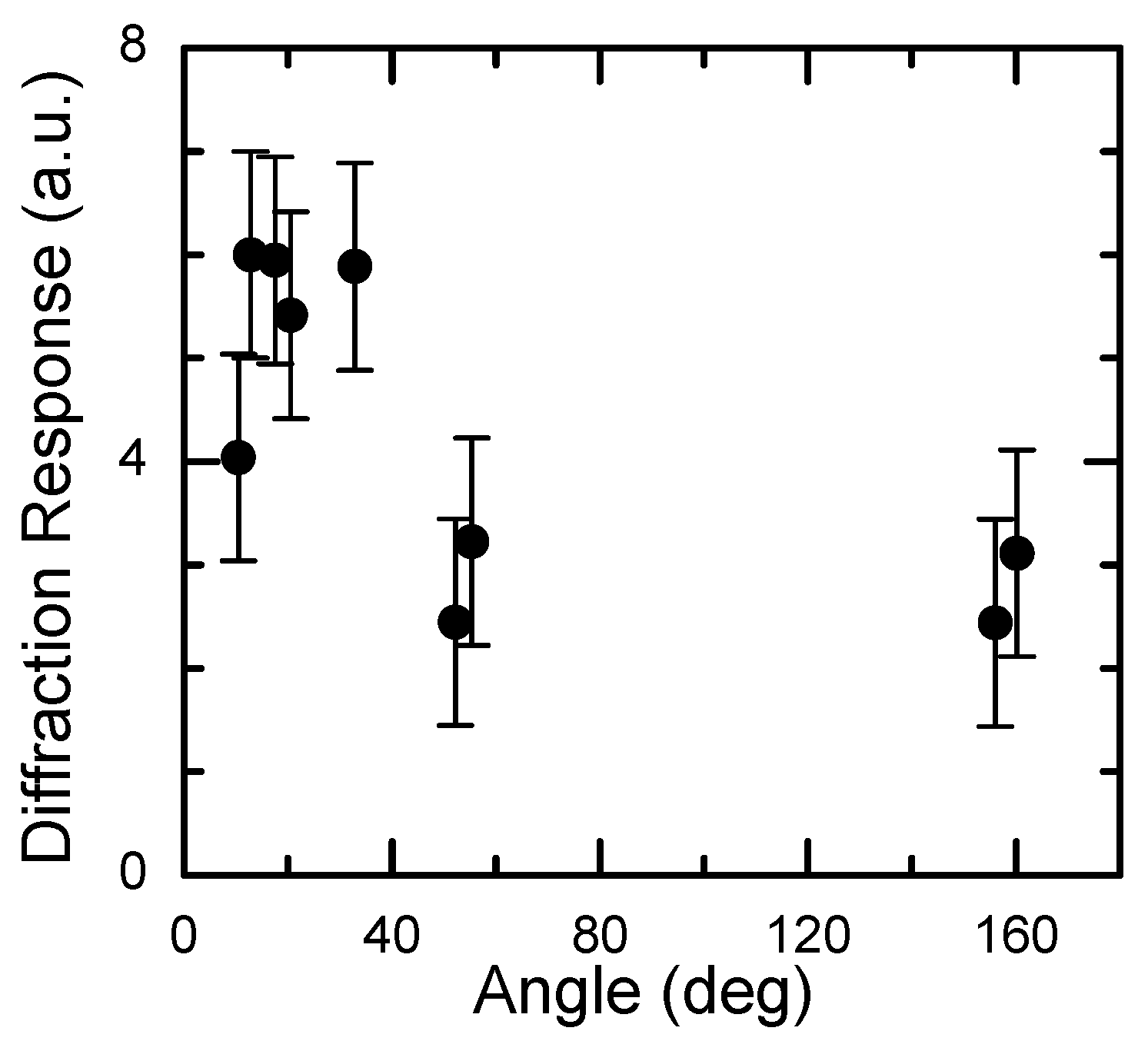
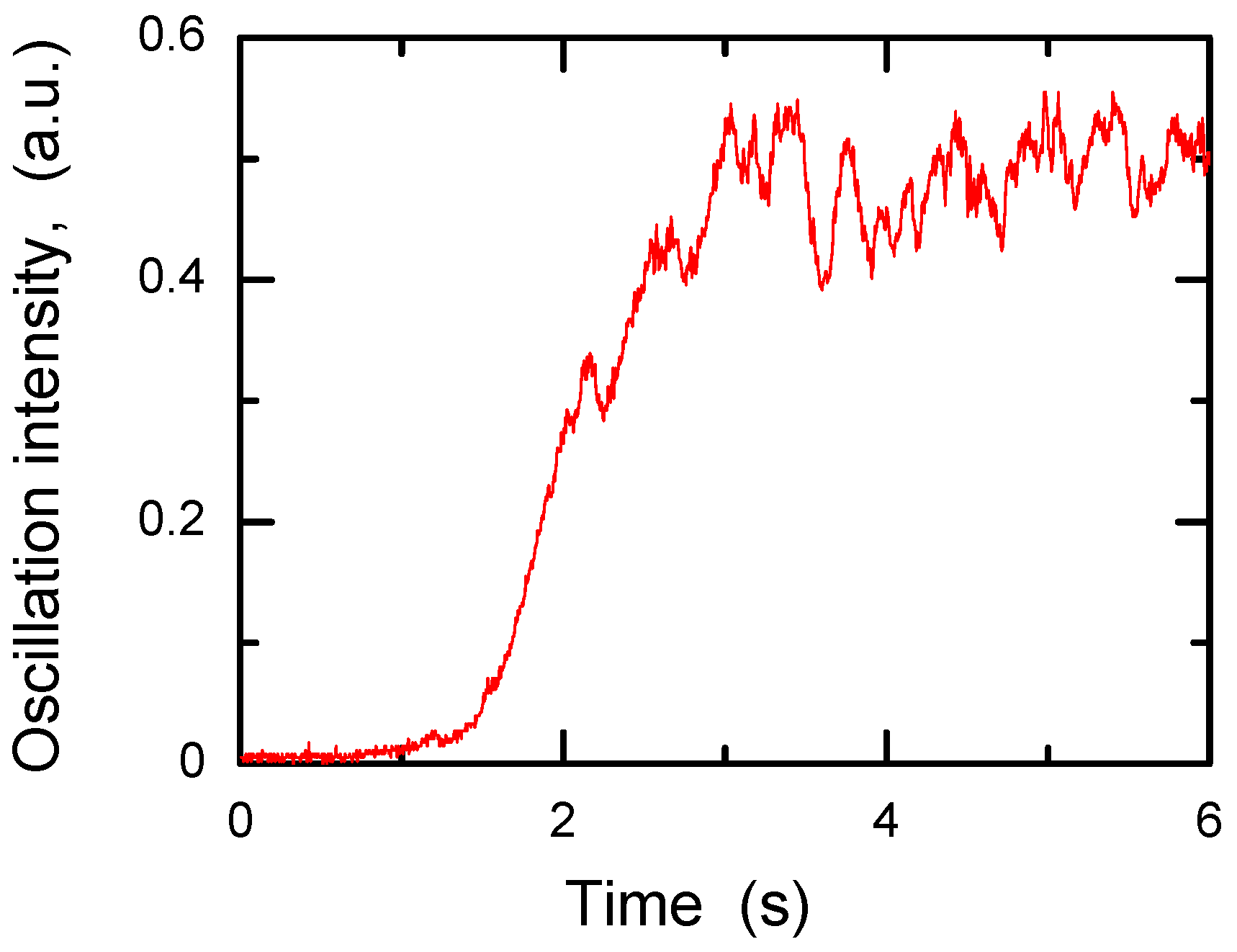
4. Holographic Optical Elements Based on Cdf2:Ga and Cdf2:in Crystals
4.1. Wavefront Correction
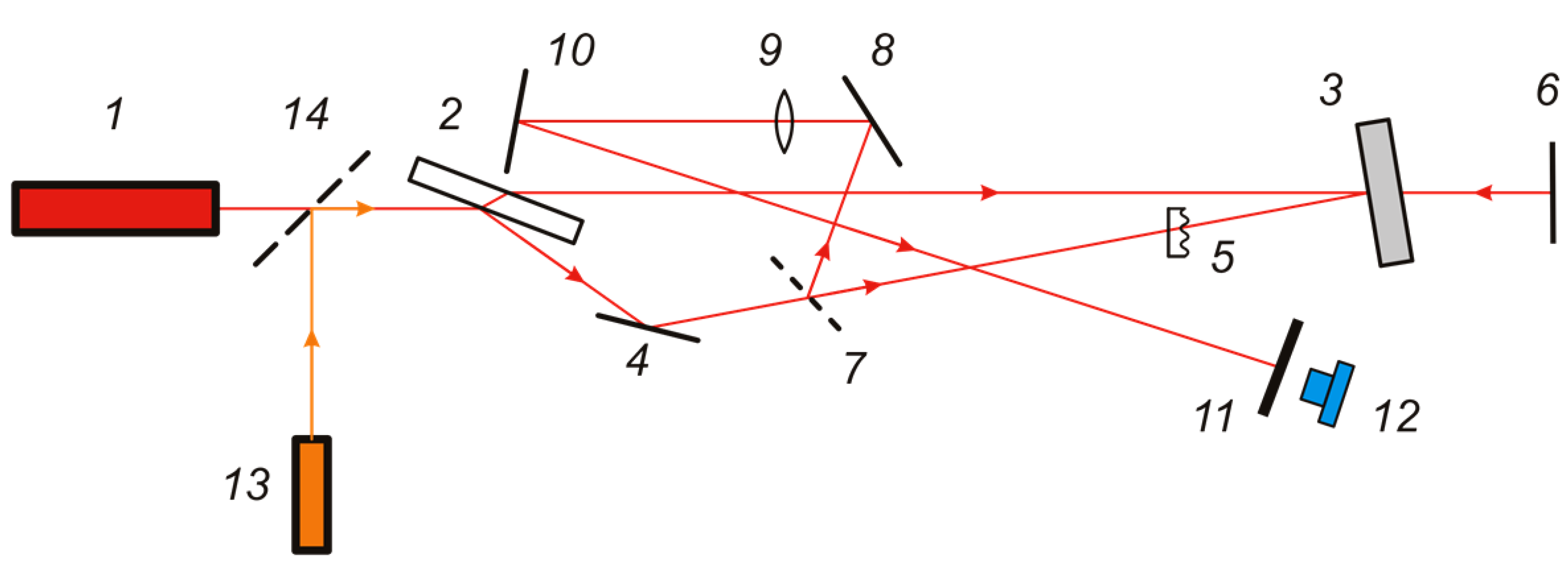
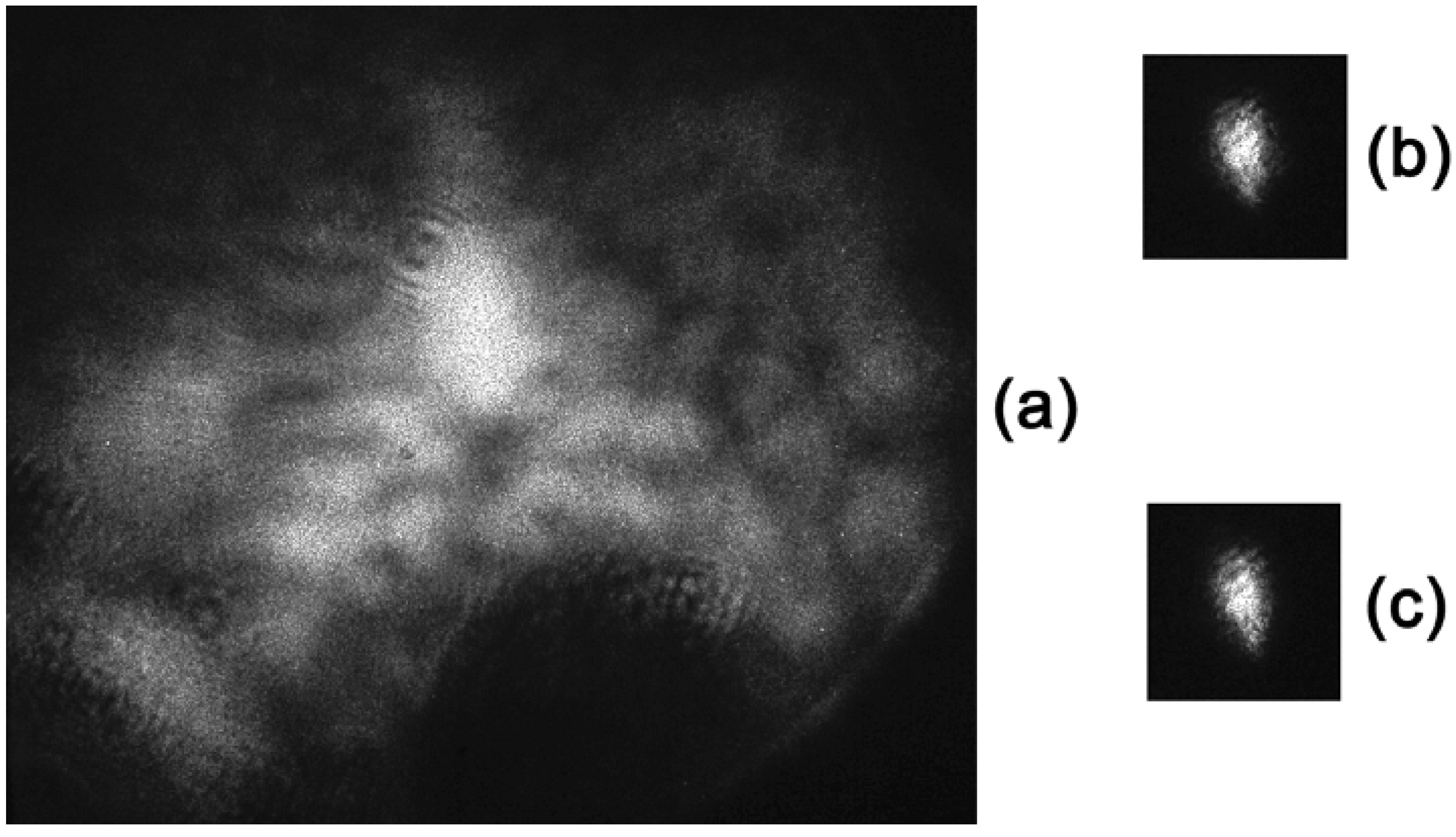

4.2. Holographic Pattern Recognition
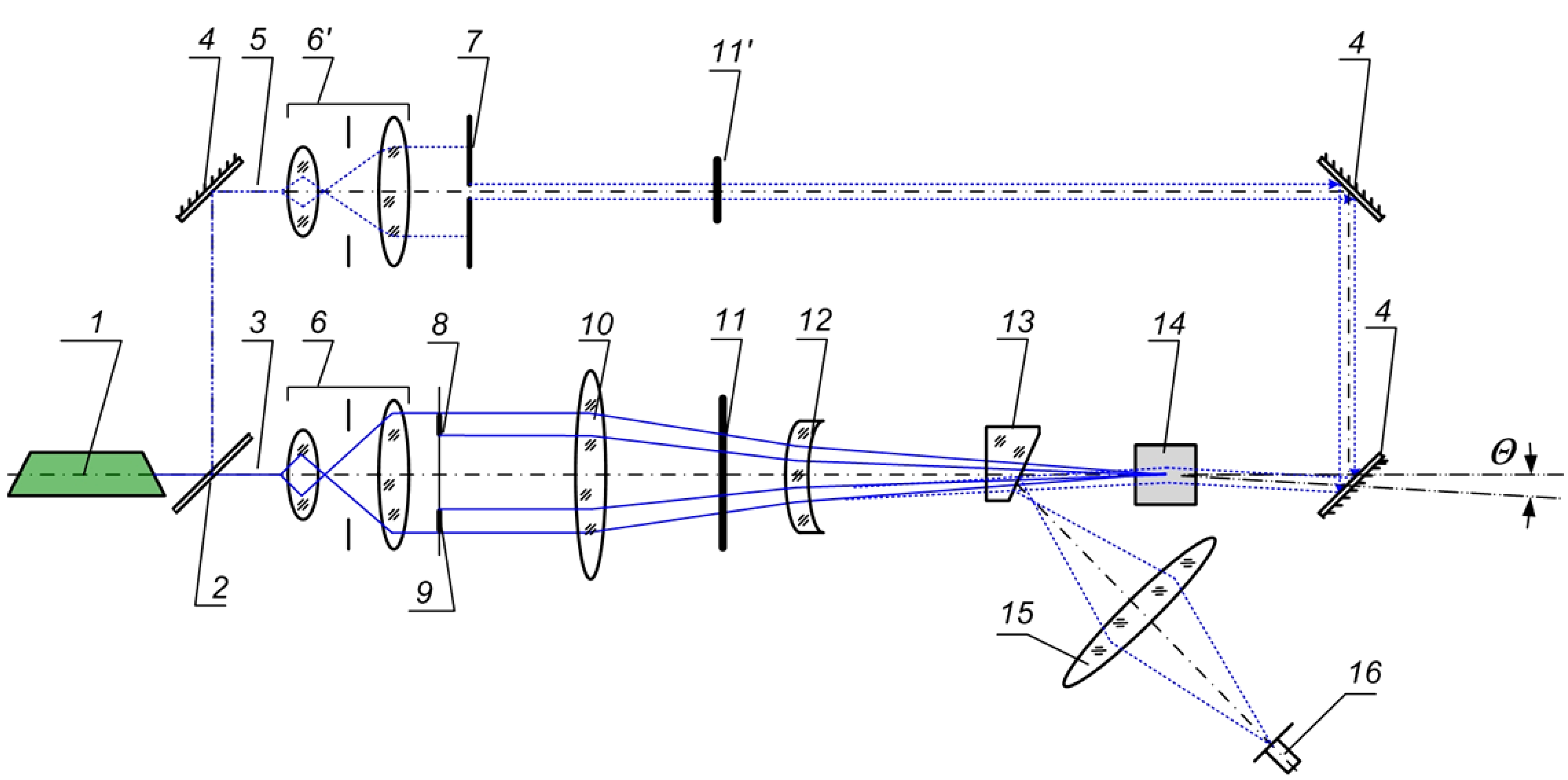
 (2), located on the right-hand side of a transparency (Figure 26a) and the analyzed objects s(x) are three hieroglyphs placed on the left-hand side of the transparency (1, 2, 3).
(2), located on the right-hand side of a transparency (Figure 26a) and the analyzed objects s(x) are three hieroglyphs placed on the left-hand side of the transparency (1, 2, 3).

5. Conclusions
References and Notes
- Linke, R.A.; Thio, T.; Chadi, J.D.; Devlin, G.E. Diffraction from optically written persistent plasma gratings in doped compound semiconductors. Appl. Phys. Lett. 1994, 65, 16–18. [Google Scholar] [CrossRef]
- Thio, T.; Bennett, J.W.; Chadi, J.D.; Linke, R.A.; Becla, P. DX centers in CdZnTe:Cl and their applications. J. Cryst. Growth 1996, 159, 345–349. [Google Scholar] [CrossRef]
- McKenna, J.M.; Nolte, D.D.; Walukiewicz, W.; Becla, P. Persistent holographic absorption gratings in AlSb:Se. Appl. Phys. Lett. 1996, 68, 735–737. [Google Scholar] [CrossRef]
- Ryskin, A.I.; Shcheulin, A.S.; Koziarska, B.; Langer, J.M.; Suchocki, A.; Buczinskaya, I.I.; Fedorov, P.P.; Sobolev, B.P. CdF2:In: A novel material for optically written storage of information. Appl. Phys. Lett. 1995, 67, 31–33. [Google Scholar] [CrossRef]
- Koziarska, B.; Langer, J.M.; Ryskin, A.I.; Shcheulin, A.S.; Suchocki, A. Use of bistable centers in CdF2 in holographic recording. Mater. Sci. Forum 1995, 1103–1108. [Google Scholar]
- Shcheulin, A.S.; Angervaks, A.E.; Ryskin, A.I.; Zakirov, R.Y.; Serov, T.V. Additive coloration of cadmium fluoride crystals. J. Opt. Technol. 2006, 73, 745–748. [Google Scholar] [CrossRef]
- Shcheulin, A.S.; Semenova, T.S.; Koryakina, L.F.; Petrova, M.A.; Kupchikov, A.K.; Ryskin, A.I. Additive coloration of calcium and cadmium fluorides. Opt. Spectrosc. 2007, 103, 660–664. [Google Scholar] [CrossRef]
- Kingsley, J.D.; Prener, J.S. Free charge carrier effects in cadmium fluoride. Phys. Rev. Lett. 1962, 8, 315–316. [Google Scholar] [CrossRef]
- Prener, J.S.; Kingsley, J.D. Mechanism of the conversion of CdF2 from an isolator to a semiconductor. J. Chem. Phys. 1963, 38, 667–671. [Google Scholar] [CrossRef]
- Khosla, R.P. Electrical properties of semiconducting CdF2:Y. Phys. Rev. 1969, 183, 695–703. [Google Scholar] [CrossRef]
- Langer, J.M.; Langer, T.; Pearson, G.L.; Krukowska-Fulde, B.; Piekara, U. Shallow donor states in semiconducting CdF2. Phys. Status Solidi (b) 1974, 66, 537–545. [Google Scholar] [CrossRef]
- Khosla, R.P.; Matz, D. Effective mass and scattering mechanisms in semiconducting CdF2 at high temperatures. Solid State Commun. 1968, 6, 859–864. [Google Scholar] [CrossRef]
- Kunze, I.; Ulrici, W. Electrical and optical studies of semiconducting CdF2:In crystals. Phys. Status Solidi (b) 1973, 55, 567–578. [Google Scholar] [CrossRef]
- Piekara, U.; Langer, J.M.; Krukowska-Fulde, B. Shallow versus deep In donors in CdF2 crystals. Solid State Commun. 1977, 23, 583–587. [Google Scholar] [CrossRef]
- Langer, J.M. Strong lattice relaxation at localized defects. J. Phys. Soc. Jpn. 1980, 49, S207–S214. [Google Scholar] [CrossRef]
- Langer, J.M. DX-like centers in solids (metastability, bistability and negative-U). Rev. Solid State Sci. 1990, 4, 297–317. [Google Scholar]
- Toyozawa, Y. Symmetry breaking excitonic instabilities in deformable lattice. Phys. B+C 1983, 117–118, 23–29. [Google Scholar] [CrossRef]
- Here and further we use two equivalent notations: shallow/deep state of the center and shallow/deep center.
- Shcheulin, A.S.; Ryskin, A.I.; Swiatek, K.; Langer, J.M. Deep-shallow transformation of bistable centers in semiconducting CdF2 crystals. Phys. Lett. A 1996, 222, 107–112. [Google Scholar] [CrossRef]
- Kazanskii, S.A.; Ryskin, A.I.; Romanov, V.V. Paramagnetic susceptibility of semiconducting CdF2:In crystals: Direct evidence of the negative-U nature of the DX-like center. Appl. Phys. Lett. 1997, 70, 1272–1274. [Google Scholar] [CrossRef]
- Kazanskii, S.A.; Ryskin, A.I.; Romanov, V.V. Paramagnetic susceptibility of additively colored CdF2:In photochromic crystals. Phys. Solid State 1997, 39, 1067–1071. [Google Scholar] [CrossRef]
- Park, C.H.; Chadi, D.J. First-principles study of structural bistability in Ga- and In-doped CdF2. Phys. Rev. Lett. 1999, 82, 113–116. [Google Scholar] [CrossRef]
- Nissilä, J.; Saarinen, K.; Hautojärvi, P.; Suchocki, A.; Langer, J. M. Universality of the bond-breaking mechanism in defect bistability: observation of open volume in the deep states of In and Ga in CdF2. Phys. Rev. Lett. 1999, 82, 3276–3279. [Google Scholar] [CrossRef]
- Ritus, A.I.; Pronin, A.V.; Volkov, A.A.; Lunkenheimer, P.; Loidl, A.; Shcheulin, A.S.; Ryskin, A.I. Determination of the parameters of semiconducting CdF2:In with Schottky barriers from radio-frequency measurements. Phys. Rev. B 2002, 65, 165209:1–165209:8. [Google Scholar] [CrossRef]
- Ionic radii of eight-coordinated Cd2+, In3+, and Ga3+ ions are 1.24 Å, 1.06 Å, and 0.78 Å, respectively.
- The excitation in the IR absorption band does not influence the absorption spectrum of the crystals due to practically instantaneous capture of the free carrier by one of the Me3+ ions with formation of the shallow donor state.
- Shcheulin, A.S.; Onopko, D.E.; Ryskin, A.I. Electronic level diagram and structure of metastable centers in CdF2:Ga and CdF2:In semiconducting crystals. Phys. Solid State 1997, 39, 1906–1911. [Google Scholar] [CrossRef]
- Ryskin, A.I.; Shcheulin, A.S.; Onopko, D.E. DX Centers in ionic semiconductor CdF2:Ga. Phys. Rev. Lett. 1998, 80, 2949–2952. [Google Scholar] [CrossRef]
- Kazanskii, S.A.; Ryskin, A.I. Electron statistics in CdF2 semiconductor crystals with DX centers. Phys. Solid State 2006, 48, 1663–1671. [Google Scholar] [CrossRef]
- Fedorov, P.P.; Buchinskaya, I.I.; Ivanov, S.P.; Sobolev, B.P.; Shcheulin, A.S.; Ryskin, A.I. A new class of holographic materials based on semiconductor CdF2 crystals with bistable centers. Part II. Growth of optically perfect crystals. Opt. Spectrosc. 2002, 92, 125–132. [Google Scholar] [CrossRef]
- Kazanskii, S.A.; Klimin, S.A.; Shcheulin, A.S.; Narozhnyi, M.A.; Ryskin, A.I. Optical spectra of (CdF2)0.9(InF3)0.1 semiconductor solid solutions. Opt. Spectrosc. 2008, 104, 861–865. [Google Scholar] [CrossRef]
- In Figure captions, NGa and NIn denote concentration of optically active bistable centers, whereas NY denotes concentration of reduced Y ions that form only shallow.
- Kazanskii, S.A.; Warren, W.W.; Ryskin, A.I. Spin-lattice relaxation of 113Cd and 19F nuclear spins in the crystal lattice of CdF2 semiconductor crystals with DX centers. Semiconductors 2009, 43, 985–992. [Google Scholar] [CrossRef]
- Eisenberger, P.; Pershan, P.S.; Bosomworth, D.R. Polaron effects in semiconducting CdF2: cyclotron resonance and far-infrared properties. Phys. Rev. 1969, 188, 1197–1208. [Google Scholar] [CrossRef]
- Kazanskii, S.A.; Rumyantsev, D.S.; Ryskin, A.I. Ionized donor pairs and microwave and far-infrared absorption in semiconducting CdF2. Phys. Rev. B 2002, 65, 165214:1–165214:12. [Google Scholar] [CrossRef]
- Stasl’ko, D.I.; Tikhomirov, S.A.; Buganov, O.V.; Shcheulin, A.S.; Angervaks, A.E.; Ryskin, A.I. Dynamics of the transformation of bistable centers and lattice in CdF2 crystals under femtosecond pulsed photoexcitation. Opt. Spectrosc. 2011, 110, 33–41. [Google Scholar] [CrossRef]
- The peak at the initial part of curve 3 in Figure 8 is due to free-carrier absorption.
- Moser, F.; Matz, D.; Lyi, S. Infrared optical absorption in semiconducting CdF2:Y crystals. Phys. Rev. 1969, 182, 808–814. [Google Scholar] [CrossRef]
- Kazanskii, S.A.; Shcheulin, A.S.; Ryskin, A.I. Energy barrier between states of a bistable center in photochromic crystals CdF2:Ga and CdF2:In. Opt. Spectrosc. 2007, 102, 419–425. [Google Scholar] [CrossRef]
- Shcheulin, A.S.; Angervaks, A.E.; Ryskin, A.I. Formation kinetics of volume holograms in reversible photochromic media. Opt. Spectrosc. 2011, 110, 609–616. [Google Scholar] [CrossRef]
- Ryskin, A.I.; Shcheulin, A.S.; Miloglyadov, E.V.; Linke, R.A.; Redmond, I.; Buchinskaya, I.I.; Fedorov, P.P.; Sobolev, B.P. Mechanisms of writing and decay of holographic gratings in semiconducting CdF2:Ga. J. Appl. Phys. 1998, 83, 2215–2221. [Google Scholar] [CrossRef]
- Linke, R.A.; Redmond, I.; Thio, T.; Chadi, D.J. Holographic storage media based on optically active bistable defects. J. Appl. Phys. 1998, 83, 661–673. [Google Scholar] [CrossRef]
- Kogelnik, H. Coupled wave theory for thick hologram gratings. AT&T Tech. J. 1969, 48, 2909–2947. [Google Scholar]
- Uesu, Y.; Yasukawa, K.; Saito, N.; Itoh, S.; Odoulov, S.; Shcherbin, K.; Ryskin, A.I. Dynamic grating recording in semiconductor CdF:Ga,Y. J. Opt. Soc. Am. Opt. Phys. B 2003, 20, 1905–1911. [Google Scholar] [CrossRef]
- Linke, R.A.; Shcheulin, A.S.; Ryskin, A.I.; Buchinskaya, I.I.; Fedorov, P.P.; Sobolev, B.P. Properties of CdF2:Ga as a medium for real-time holography. Appl. Phys. B 2001, 72, 677–683. [Google Scholar] [CrossRef]
- Ryskin, A.I.; Shcheulin, A.S.; Kazanskii, S.A.; Angervaks, A.E. CdF2 Crystals with bistable impurity centers as media of the real-time holography. J. Luminesc. 2007, 125, 18–24. [Google Scholar] [CrossRef]
- Concentration of optically active bistable centers, i.e., centers that can form both deep and shallow state, was ~1018 cm−3 for both crystals. One should note that holographic characteristics of CdF2:Ga and CdF2:Ga,Y crystals are similar to each other.
- The cross-section of electron capture by Me3+ ion is so high that an electron formed after photoionization of the shallow center is captured by an ionized center or another Me3+ ion practically instantly.
- Uesu, Y.; Yasukawa, K.; Saito, N.; Odoulov, S.; Shcherbin, K.; Ryskin, A.I.; Shcheulin, A.S. Backward-wave four-wave mixing and coherent oscillation in CdF2:Ga, Y. Appl. Phys. B 2004, 78, 601–605. [Google Scholar] [CrossRef]
- Nahata, A.; DiCaprio, C.J.; Yamada, H.; Ryskin, A.I.; Shcheulin, A.S.; Linke, R.A. Widely tunable distributed Bragg reflector laser using a dynamic holographic grating mirror. IEEE Photonic Technol. Lett. 2000, 12, 1525–1527. [Google Scholar] [CrossRef]
- Shcheulin, A.S.; Verkhovskii, E.B.; Angervaks, A.E.; Ryskin, A.I. Recording of dynamic information holograms in a CdF2:In crystal. Opt. Spectrosc. 2005, 99, 803–805. [Google Scholar] [CrossRef]
- Angervaks, A.E.; Dimakov, S.A.; Kliment’ev, S.I.; Ryskin, A.I.; Shcheulin, A.S. Dynamic wavefront-conjugating mirror based on CdF2 crystals with bistable in centers. Opt. Spectrosc. 2006, 101, 131–135. [Google Scholar] [CrossRef]
- Angervaks, A.E.; Dimakov, S.A.; Kliment’ev, S.I.; Ryskin, A.I.; Shcheulin, A.S. Dynamic reflection holograms in CdF2 crystals with bistable centers. Opt. Spectrosc. 2002, 93, 307–314. [Google Scholar] [CrossRef]
- Fedorov, I.Yu.; Angervaks, A.E.; Sokolov, V.K.; Shcheulin, A.S. Dynamic holographic joint fourier transform correlator based on a CdF2:Ga crystal. Opt. Spectrosc. 2008, 105, 962–971. [Google Scholar] [CrossRef]
- Tripathi, R.; Singh, K. Pattern discrimination using a bank of wavelet filters in a joint transform correlator. Opt. Eng. 1998, 37, 532–538. [Google Scholar] [CrossRef]
- Joseph, J.; Oura, T.; Minemoto, T. Optical implementation of a wavelet transform by the use of dynamic holographic recording in a photorefractive material. Appl. Opt. 1995, 34, 3997–4003. [Google Scholar] [CrossRef] [PubMed]
- Zhang, H.; Cartwright, C.M.; Ding, M.S.; Gillespie, W.A. Optical implementation of a photorefractive joint transform correlator with wavelet filters. Opt. Commun. 2000, 181, 223–230. [Google Scholar] [CrossRef]
- Widjaja, J. Wavelet filter for improving detection performance of compression-based joint transform correlator. Appl. Opt. 2010, 49, 5768–5776. [Google Scholar] [CrossRef] [PubMed]
© 2012 by the authors; licensee MDPI, Basel, Switzerland. This article is an open access article distributed under the terms and conditions of the Creative Commons Attribution license (http://creativecommons.org/licenses/by/3.0/).
Share and Cite
Ryskin, A.I.; Shcheulin, A.S.; Angervaks, A.E. Semiconductor CdF2:Ga and CdF2:In Crystals as Media for Real-Time Holography. Materials 2012, 5, 784-817. https://doi.org/10.3390/ma5050784
Ryskin AI, Shcheulin AS, Angervaks AE. Semiconductor CdF2:Ga and CdF2:In Crystals as Media for Real-Time Holography. Materials. 2012; 5(5):784-817. https://doi.org/10.3390/ma5050784
Chicago/Turabian StyleRyskin, Alexander I., Alexander S. Shcheulin, and Alexander E. Angervaks. 2012. "Semiconductor CdF2:Ga and CdF2:In Crystals as Media for Real-Time Holography" Materials 5, no. 5: 784-817. https://doi.org/10.3390/ma5050784




